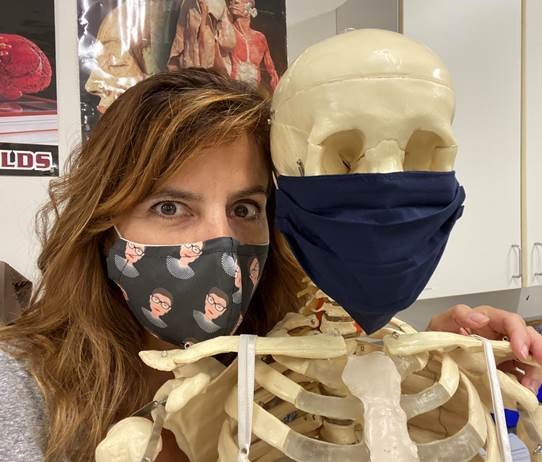

Christine Karlberg with Cornelius in her classroom.
An administrator called me a Luddite once in a staff meeting. Well, to be clear, she used that term for all of us experienced teachers who regularly chose not to jump on the newest iteration of the bright and shiny technological bandwagon. We were the ones who did not immediately embrace the 3D goggles contraption for cellphones or develop escape room lockbox activities or integrate the app du jour.
Nothing like a global pandemic to throw us all into the deep end of the technological pool. Now we can all Google Suite, Screencastify, and Zoom proficiently with our tech-savvy peers.
While I did learn and utilize these technologies, I also held tight to the tried-and-true activities with proven efficacy over two decades of teaching. My students and I drew together on whiteboards and in journals, we built models out of trash and recyclables, and we discussed and connected our content to natural phenomena.
I also continued using my most analog of tools — the humble postcard. Yes, I am referring to (gasp!) snail mail. For years, I have been sending a handwritten postcard to the homes of my students and their families when they do something that catches my attention and is worthy of praise and positive reinforcement.
Schools in large districts often have postcards available to teachers for this purpose. At my stand-alone public charter school, we originally did not. I was gearing up to write a DonorsChoose grant to try to acquire the postage paid cards, but decided to ask an administrator (yes, the same one who called me a Luddite) if there were funds available to start such a program for our campus. I was surprised and pleased to find that there were, and our school administration has financially supported this program for several years now. (If you decide to try initiating this type of “positivity post” program at your school, I am confident that grant funding can help get you started.)
I have a personal goal to send out at least two cards per week, and I maintained that during distance learning last year. I thanked the students who were in class on time with their cameras on and positively participating. I gushed to the kids who would break the interminable silence and bravely share their ideas with the group. I shared with parents how their child had connected to something that I hadn’t even considered and taught me something new that day.
Those are the easiest cards to write and the messages flow easily onto the cardstock. It can be harder to find that message for some students, but it is always there: an infectious grin and sense of humor, submitting an assignment that was challenging, serving as a role model for others, volunteering to be the facilitator for the lab group, being the student who was brave enough to raise a hand when others wouldn’t… The smallest of things that recognize and individualize a student makes them realize they are seen and valued. I have found that their affect and effort in my class improve as a result, and this can spread to those around them.
Almost without fail a few days after the postcard is mailed, I receive a lengthy email from the parent or student thanking me for taking the time to send the card. Even in these digital days of instant email gratification, there is just something special about receiving a handwritten card in our mailbox. Whether it goes on the refrigerator or in a scrapbook, or maybe it is even read and tossed, the message and gratitude remain there for the remainder of that school year and beyond, and the benefits of that are truly bright and shiny.
Christine Karlberg teaches anatomy and zoology, and is a member of Orange County School of the Arts Teachers Association.
The Discussion 0 comments Post a Comment